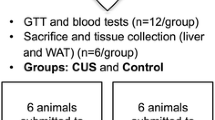Abstract
Inflammatory stress as characterized by infection withStreptococcus pneumoniae, administration of endotoxin, or the induction of a turpentine abscess is characterized by the inhibition of the ketosis associated with fasting and a decline in the level of free fatty acids in the plasma. Moreover, rats subjected to these inflammatory stresses demonstrate a significant rise in peripheral and portal insulin and glucagon. Rats subjected to noninflammatory stresses, screen-restraint, or noninvasive femoral fracture did not demonstrate the inhibition of ketosis but did show a decrease in plasma free fatty acids. The noninflammatory stresses did not show an abnormal elevation of plasma or portal insulin or glucagon.
Similar content being viewed by others
References
Neufeld, H. A., M. V. Kaminski, Jr., J. A. Pace, andH. A. Stuhl. 1976. The effect of inflammatory and noninflammatory stress on ketosis in the rat.Fed. Proc. 35:1502 (abstract).
Askew, E. W., G. L. Dohn, andK. L. Huston. 1975. Fatty acid and ketone body metabolism in the rat: Response to diet and exercise.J. Nutr. 105:1422.
Askew, E. W., R. L. Huston, C. G. Plopper, andA. L. Hecker. 1975. Adipose tissue cellularity and lipolysis. Response to exercise and cortisol treatment.J. Clin. Invest. 56:521.
Johnson, R. H., andJ. L. Walton. 1971. Fitness, fatness, and post-exercise ketosis.Lancet 1:566.
Johnson, R. H., J. L. Walton, H. A. Krebs, andD. H. Williamson. 1969. Metabolic fuels during and after severe exercise in athletes and non-athletes.Lancet 2:452.
Johnson, R. H., J. L. Walton, H. A. Krebs, andD. H. Williamson. 1969. Post-exercise ketosis.Lancet 2:1383.
Mole, P. A., L. B. Oscai, andJ. O. Holloszy. 1971. Adaptation of muscle to exercise. Increase in levels of palmityl CoA synthetase, carnitine plamityltransferase, and palmityl CoA dehydrogenase, and in the capacity to oxidize fatty acids.J. Clin. Invest. 50:2323.
Winder, W. W., K. M. Baldwin, andJ. O. Holloszy. 1973. Exercise-induced adaptive increase in rate of oxidation of β-hydroxybutyrate by skeletal muscle.Proc. Soc. Exp. Biol. Med. 143:753.
Blackburn, G. L., J. P. Flatt, G. H. A. Clowes, T. E. O'Donnell, andT. E. Hensle. 1973. Protein sparing therapy during periods of starvation with sepsis and trauma.Ann. Surg. 177:588.
Ryan, N. T., G. L. Blackburn, andG. H. A. Clowes, Jr. 1974. Differential tissue sensitivity to elevated endogenous insulin levels during experimental peritonitis in rats.Metabolism 23:1081.
Neufeld, H. A., J. A. Pace, andF. E. White. 1976. The effect of bacterial infections on ketone concentrations in rat liver and blood and free fatty acid concentrations in rat blood.Metabolism 25:877.
Rossi, G., S. Bonfils, F. Lieffogh, andA. Lambling. 1956. Technique nouvelle pour produire des ulcérations gastriques chez le rat blanc: l'ulcére de contrainte.C.R. Soc. Biol. (Paris) 150:2124.
Brodie, D. A., andH. M. Hanson. 1960. A study of the factors involved in the production of gastric ulcers by the restraint technique.Gastroenterology 38:353.
Williamson, D. H., J. Mellanby, andH. A. Krebs. 1962. Enzymic determination of D(−)-β-hydroxybutyric acid and acetoacetic acid in blood.Biochem. J. 82:90.
Dalton, C., andC. Kowalski. 1967. Automated colorimetric determination of free fatty acids in biologic fluids.Clin. Chem. 13:744.
Juan, C., andT. A. Avrurskin. 1971. A combined immunoassay of human growth hormone and insulin: cumulative assessment of assay performance.J. Clin. Endocrinol. Metab. 33:150.
Ohneda, A., E. Aguilar-Parada, A. M. Eisentraut, andR. H. Unger. 1969. Control of pancreatic glucagon secretion by glucose.Diabetes 18:1.
Neufeld, H. A., M. V. Kaminski, Jr., andR. W. Wannenmacher, Jr. 1977. Effect of inflammatory and noninflammatory stress on ketone bodies and free fatty acids in rats.Am. J. Clin. Nutr. 30:1357.
Author information
Authors and Affiliations
Additional information
The views of the authors do not purport to reflect the positions of the Department of the Army or the Department of Defense.
In conducting the research described in this report, the investigators adhered to the “Guide for the Care and Use of Laboratory Animals,” as promulgated by the Committee on the Revision of the Guide for Laboratory Animal Facilities and Care of the Institute of Laboratory Animal Resources, National Research Council. The facilities are fully accredited by the American Association for Accreditation of Laboratory Animal Care.
Rights and permissions
About this article
Cite this article
Kaminski, M.V., Neufeld, H.A. & Pace, J.G. Effect of inflammatory and noninflammatory stress on plasma ketone bodies and free fatty acids and on glucagon and insulin in peripheral and portal blood. Inflammation 3, 289–294 (1979). https://doi.org/10.1007/BF00914186
Issue Date:
DOI: https://doi.org/10.1007/BF00914186




